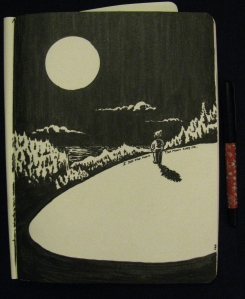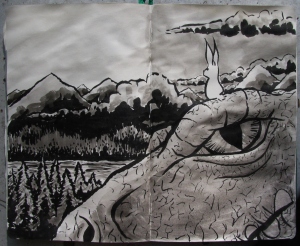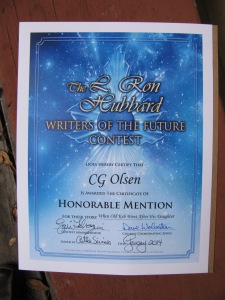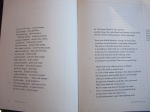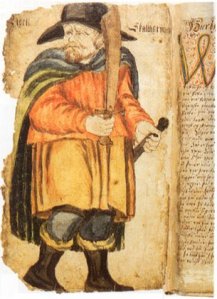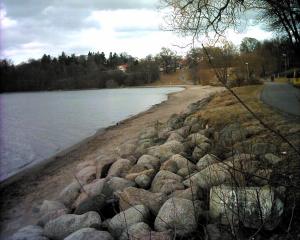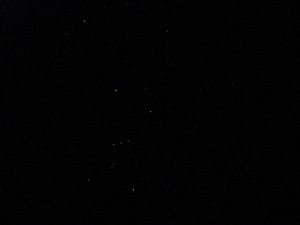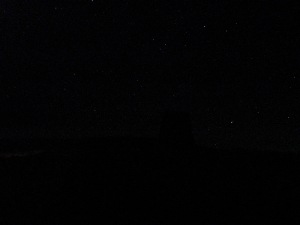
Sigurd on the Ramsund stone.
My goodness, is it really World Poetry Day again? Can’t believe a whole year has gone by since my last WPD post. Note that the WPD announcement from UNESCO (linked to above) features a picture of a manuscript of the Nibelungenlied, the epic account of Siegfried the Dragon Slayer, his death, and the aftermath. This traditional material is quite prominent in Norse sources as well. I often refer to it as the Volsung tradition or legend, after Völsungasaga, a fornaldarsaga (saga of ancient times, or legendary saga) written in 13th century Iceland. The saga itself has always felt a bit disjointed to me, as the complier is clearly struggling to turn all the disparate traditions at his disposal into one coherent account, but that in itself makes it interesting as a window into the transition from oral discourse to literary discourse. Manuscript production was still characterized by “variance,” so we aren’t hitting the extreme textual fixity of print culture yet, but it is kind of neat, in this saga and elsewhere, to see the wake of a still living tradition, whether through the cracks of the manuscript version, or explicitly referenced (as when the author of Grettis saga notes the different accounts of certain episodes).
The Völsungs show up in both of the Eddas as well, which gives me a nice “in” to briefly discuss the difference between Eddic and Skaldic poetry for my World Poetry Day post. The Eddas themselves give us a nice starting point, as they are each primarily associated with one or the other.

Snorri the chieftain (not the 8th dwarf)
Prose Edda, aka Snorra Edda or Younger Edda, was written around 1220/1230 by the Icelandic Chieftain Snorri Sturluson as a poetics (in fact, one etymology for “Edda” would derive it from Latin edo/edere (I compose/to compose), even if we often use it for its accounts of Norse mythology. The name “Edda” comes from this work, as it is referred to as “Edda” (and attributed to Snorri) in the Uppsala manuscript. We now call the type of poetry discussed here “Skaldic,” after the Old Norse word for poet, “Skald.” While it is not primarily determined by meter (well, depending on who is doing the defining), the “poster child” for so-called “Skaldic” poetry is dróttkvætt, “court-meter,” a very demanding form which, unlike eddic, has a set number of syllables per line (OK, “set number of syllables” is not the best way to put it, as at least two linguist friends have reminded me, but this is a common way to describe the difference between dróttkvætt and eddic in introductory books), as well as relatively demanding rules for alliteration and internal rhyme. “Skaldic” poetry also involves especially prominent use of kennings. These poetic circumlocutions are common elsewhere (for example, “whale road” for “ocean” in Beowulf), including Eddic Poetry, but they are taken to a whole new level (several new levels, maybe) in Skaldic poetry. Many of these kennings depend on mythological allusions, hence Snorri’s thorough treatment of mythology in his Edda. It has been argued that he wrote the sections of his treatise in reverse order, starting with Háttatal (Tally of meters, a relatively straightforward presentation of examples of various meters), Skáldskaparmál (Poetic Diction, which explains kennings and heiti [poetic names] by giving the relevant stories behind them, or, in the latter part, just listing the terms), Gylfaginning (The Deluding of Gylfi, an account of major myths from the beginning of the world up to the end via a frame narrative, which allows the stories to be passed off as “lies” while still laid out for our examination), and a prologue which may or may not have been written by Snorri (scholars disagree), but which, with the frame narrative of Gylf., highlights the fictionality of the myths in juxtaposition with official Christian history. The Völsungs don’t come into Snorra Edda all that much–just a 5 page summary or so, plus some references in examples of skaldic poetry (for example, Bragi’s Ragnarsdrápa).
Poetic Edda, aka Elder Edda or Saemundar Edda, refers primarily to the Codex Regius manuscript written sometime around 1270, although larger and smaller portions may be found elsewhere (including quotations in Gylfaginning). The manuscript was discovered by Icelandic Bishop Brynjólfr Sveinsson in the 17th century. The bishop decided this was another Edda and attributed it to the learned Sæmundr Sigfusson, who lived slightly over a century before Snorri. However, we only know Sæmundr to have written in Latin, and the text as we have it is from much later, so I prefer to call it Poetic Edda. The age of the poems themselves varies. Some are widely believed to come from the Viking Age, but there certainly would have been a good amount of change over the years (this is the rule with oral tradition–not to say that there cannot be exceptions, as we will discuss below). Others are much more contested, and it looks like the collection of the poems itself grew from many smaller collections. The text of Codex Regius moves from an overview of mythic history in Völuspá, to poems about the gods (possibly chosen to represent the “Big Three,” Odin, Frey, and Thor), to poems about minor supernatural beings (the elf Völund and the dwarf “All-Wise”), and then heroic poems about the Völsungs–first three Helgi poems (themselves fascinating as examples of the plurality of traditions) and then on to the story of Sigurd, and the eventual disintegration of the aristocratic family at the heart of the story. We get several different meters in the collection, but in contrast with dróttkvætt they are not as strict, still alliterating, but counting “beats” instead of syllables and leaving off the regular internal rhyme. Generally speaking, it runs in the tradition of other early medieval Germanic poetry, the so-called “long-line.” There is of course a lot more to say about this, but until I have time to expand this (or write a new post), I suggest you check out the metrical notes on pp xxviff of Carolyne Larrington‘s translation of Poetic Edda and Andy Orchard‘s introduction to his translation, pp xxx and following (both are excellent resources, btw–and as far as Prose Edda goes, I recommend Anthony Faulkes‘ translation).
It has been pointed out before that meter is insufficient to distinguish between what we label as “Skaldic” and “Eddic,” as some key examples of what we consider “Skaldic” have been written in an Eddic meter (and Snorri himself gives examples of “Eddic” meters in his Háttatal). We could argue that skaldic is primarily encomium, composed in praise of someone, while eddic is primarily narrative, but that doesn’t work so well either, as the examples of skaldic in the sagas are put to such a wide range of uses–in particular, the earliest and most canonical examples of skaldic perform their praise of their subject by telling mythic and heroic stories, obliquely praising the patron by juxtaposing him with the deeds of the gods (the idea of oblique praise coming from Margaret Clunies Ross, who also has a great introduction to Old Norse poetry and poetics, as I mentioned in my poetry post last year).
I feel that the best way to differentiate between the two, both in terms of contemporary scholarship’s “instinct” for identifying the two, as well as the way they are treated in the Old Norse texts, is in terms of the text’s perceived relationship to an original composer and performance. The so-called eddic poems tend to be treated as the products of tradition–they are received, and while modified for the needs of particular performances (as Lars Lönnroth has noted re: Hjálmar’s Death Song), the “work” as such does not seem to be understood as explicitly the creation of a Poet. Skaldic poetry, on the other hand, carries its perceived origin with it (I say “perceived” because there are plenty of stanzas we don’t think are “genuine,” but which are presented as the work of a particular person in a particular time and place). Stanzas and entire poems are attributed to a specific skald, and often are explicitly placed in historical time and space. This may simply be a feature of the tradition/prose text accompanying the poem in its transmission, but it also works its way into the poem itself quite often, as the skalds would not only tell a story, but would reflexively articulate the performance situation, asking the patron and audience to listen, explaining (often via the mythic frame of the myth of the mead of poetry) that he (the skald) has been asked to, or is about to, present a poetic gift. We find similar reflexivity at the end of the poem, while the middle sections for the most part tell the “story,” with further reflexive intrusions in the refrain. We might argue that the severe metrical restrictions of dróttkvætt give the text of skaldic a greater degree of fixity than, say, eddic (or most other traditions of oral poetry), but in addition we can suggest that the relationship of later performers to the skaldic text would also contribute to a relative degree of fixity–the text gets its value, after all, from its origin, as a canonical performance located within the history of the Scandinavian aristocratic class. With skaldic, the authenticity (and subsequent capital) of the text is derived from an originary moment (ie, it is valuable as “the words said at that moment”), whereas the authenticity of eddic is derived from its relationship to tradition–the story is the inheritance, the specific performance is incidental.
Well, hope that made some sense–I’ve been picking away at ways to articulate this for a while, in my entries on the Eddas for The Literary Encyclopedia as well as in the final chapter of my dissertation (where I threw in a bit more theory from work in folkloristics and oral performance). In any case, have a very happy World Poetry Day! I’ve also been picking away at editing some poems of my own (both from visits to Iceland–one in 2005, the other near the end of my dissertation research in 2009), will see if I can get them in good enough shape to send them off anywhere…
Read Full Post »
